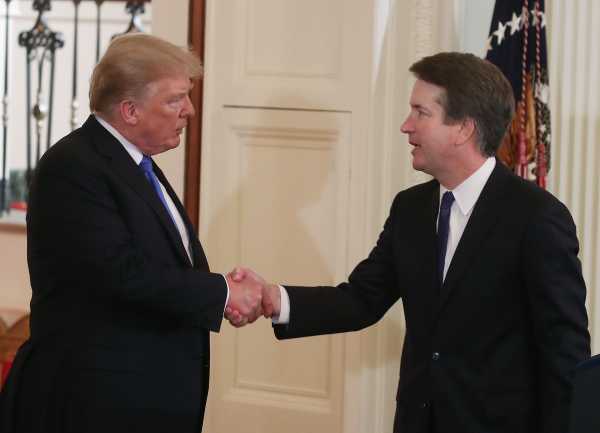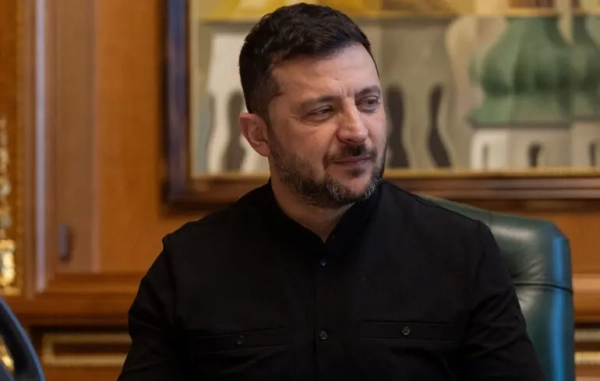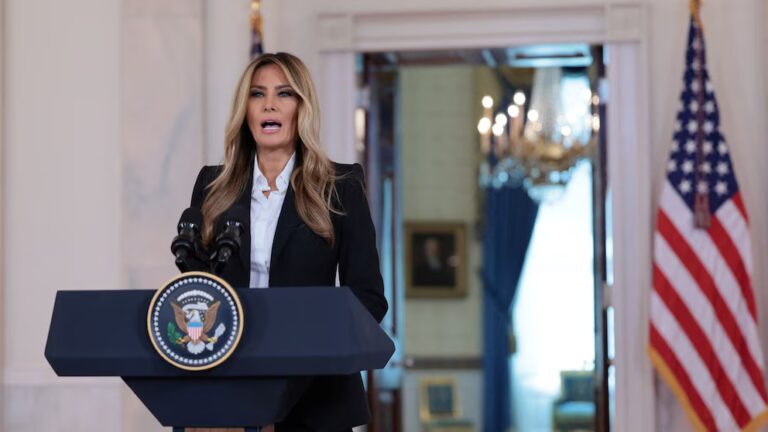
When Supreme Court nominee Brett Kavanaugh is confirmed (which, given the composition of the Senate, feels almost like an inevitability), there will quite possibly be a 5-4 majority on the Court to overturn Roe v. Wade (depending on how Chief Justice John Roberts votes — more on him here and below).
Kavanaugh will pretend this isn’t the case. Some conservatives — either to own the libs and prove that Kavanaugh isn’t a threat to women or to express concern about the choice — have cited his statement in his 2006 confirmation hearing that, “if confirmed to the D.C. Circuit, I would follow Roe v. Wade faithfully and fully.”
But if you watch Sen. Chuck Schumer’s questioning in that hearing, it’s incredibly obvious that Kavanaugh is dodging:
As a circuit court judge, Kavanaugh was bound in almost every case to obey Supreme Court precedent faithfully. He could try to bend that precedent, for sure, or argue that certain precedents have been superseded by subsequent rulings (that’s what four appellate courts did in 2014 when they overturned bans on same-sex marriage, despite the Supreme Court’s 1972 ruling in Baker v. Nelson that marriage equality didn’t present a “substantial federal question”).
But he has to follow Roe and Casey (the 1992 ruling reaffirming the “core holding” of Roe). That’s just what the rules say. Kavanaugh was using this formality to dodge Schumer’s line of questioning.
The Supreme Court, by contrast, can overturn its own precedents. It’s usually hesitant to do so, but just this term it threw out three decades-old rulings: 1977’s Abood v. Detroit Board of Education, 1967’s National Bellas Hess v. Illinois, and 1992’s Quill Corp. v. North Dakota. There’s nothing stopping Roe and Casey (and, more recently, 2016’s Whole Woman’s Health v. Hellerstedt) from joining them, and Kavanaugh’s statements about his role on the DC Circuit tell us absolutely nothing about how he’d vote as a Supreme Court justice.
And there are strong signals that Kavanaugh would personally vote to overturn Roe, or at least drastically weaken it. In a speech last year to the American Enterprise Institute, Kavanaugh praised then-Associate Justice William Rehnquist’s dissent in Roe at length. I’m going to quote the whole passage, because it’s important:
Kavanaugh is being a bit coy here, but here are some things he clearly states:
To paraphrase Kavanaugh, even a first-year formal logic student could tell you what that implies Kavanaugh’s position on Roe and Casey is.
After the talk, a questioner turns Kavanaugh’s subtext into glorious text:
Kavanaugh demurred, telling Johnswick (assuming the transcriber got Chris’s last name right) that, “I don’t know if I can improve upon just that bare description of what he did.” But he didn’t dispute the characterization of him as agreeing with Rehnquist’s dissents in Roe and Casey.
There’s other evidence that Kavanaugh is anti-Roe and anti-Casey as well. In a 2000 interview on CNN, after the Supreme Court struck down a Nebraska law banning dilation-and-extraction abortions (which opponents call “partial-birth” abortions), Kavanaugh commented, “I think the Court, eight years ago in Casey, thought it was calling an end to the national controversy over abortion. I think the court misperceived that the issue would stay front and center, and I think Justice Kennedy’s dissent yesterday indicates some deep unease by him about the course of the Court on this issue.” To liberal Kavanaugh skeptics, that suggests he thinks (or thought 18 years ago) that abortion is not a settled issue in constitutional law, and can and should be revisited.
Finally, Kavanaugh’s record in the case of Garza v. Hargan, which concerned a 17-year-old unauthorized immigrant’s attempt to secure an abortion while in government custody has given abortion rights advocates (and some more extreme anti-abortion advocates) pause. Kavanaugh, alongside Reagan appointee Karen Henderson, issued a ruling that the Office of Refugee Resettlement, which handles the care of unaccompanied minors in federal custody, did not have to let Jane Doe obtain an abortion, assuming she could find a “sponsor” (typically a family member or other guardian) and that the delay to find a sponsor wouldn’t “unduly burden the minor’s right” to the procedure. Patricia Millet, the third member of the DC Circuit panel and an Obama appointee, dissented strenuously.
The DC Circuit reheard the case en banc (that is, as a whole court, not just a panel) and overturned the panel’s decision, enabling the girl to have an abortion the next morning. Kavanaugh, this time, was the one to strenuously object, joined by Henderson and Thomas Griffith (a fellow Bush nominee):
Put another way, they viewed the DC Circuit’s majority as unreasonably reading Roe v. Wade to protect the right to abortion as absolute, when the Supreme Court has allowed for “reasonable regulations that do not impose an undue burden.” Kavanaugh and his fellow conservatives argued that forcing Jane Doe to wait until she had a sponsor did not impose such an undue burden.
Of concern to social conservatives was Kavanaugh’s writing in the case that, “All parties to this case recognize Roe v. Wade and Planned Parenthood v. Casey as precedents we must follow. All parties have assumed for purposes of this case, moreover, that Jane Doe has a right under Supreme Court precedent to obtain an abortion in the United States.”
By contrast, Henderson, the Reagan appointee, wrote her own dissent from the en banc ruling, in which she insisted, in a header no less, “J.D. Has No Constitutional Right to An Abortion,” on the grounds that she has “no connection to the United States … and cannot avail herself of the constitutional rights afforded those legally within our borders.” Henderson condemned the ruling as part of a “pantheon of abortion-exceptionalism cases.”
Kavanaugh did not join that dissent, provoking the ire of social conservatives like former Virginia Attorney General Ken Cuccinelli, who told Politico’s Josh Gerstein, “[Kavanaugh’s] view there was just quite troubling … You wouldn’t be hearing about this really and it certainly would not be causing people to have concern if Kavanaugh joined Henderson’s opinion.”
That said, Cuccinelli’s anxiety reeks of overreading tea leaves, and more mainstream conservatives like National Review’s Ed Whelan have vigorously defended Kavanaugh on the case.
How overturning Roe would work
I’m quite confident that Kavanaugh is a vote to overturn Roe and Casey.
But he won’t be the median justice on the Court once confirmed. That will be John Roberts, and the big question now is whether his belief in stare decisis, the Supreme Court practice of generally obeying precedent unless they believe it contains a grievous error, will override his personal desire to blow up abortion jurisprudence.
My colleague Dylan Scott has a great piece diving into this question specifically. As Scott notes, Roberts, as deputy solicitor general in 1990, wrote a brief arguing that Roe was “wrongly decided and should be overruled.” But he quotes NYU law professor Melissa Murray as explaining that, “As chief justice, Roberts has evinced particular concerns about overruling settled precedents … [and] as chief justice, he has been especially concerned about preserving the Court’s legitimacy and public stature.”
His decision to uphold the Affordable Care Act is a prime example of this tendency. His gradual efforts to roll back the Voting Rights Act and public-sector unions, by contrast, are an example of his willingness to rock the boat to get a conservative outcome, as Irin Carmon details in the Washington Post.
You can go back and forth on where Roberts will land seemingly forever. William Saletan at Slate has a piece making the case that Roe will survive, while UC Irvine constitutional law professor Leah Litman argues it’s done for.
But it’s worth asking in addition what overturning Roe will look like. There are two broad ways it could happen. The first is the overturn-without-overturning approach. The second is a full-on reversal.
Kavanaugh has, in the Garza v. Hargan case, already suggested what an overturn-without-overturning approach could look like. Not to be too hyperbolic, but he argued that literally keeping a girl in detention to keep her from getting an abortion was not an undue burden on her right to an abortion. That might seem implausible (it certainly did to the rest of the DC Circuit) but it offers a pathway to allowing other extreme restrictions on abortion rights.
Mark Joseph Stern at Slate, a consistent pessimist about the Court’s willingness to keep liberal precedents like Roe, has outlined one path this could take:
That’s a pretty extreme case; fetal heartbeats are often present at six weeks, and it’s beyond laughable to argue that allowing bans on abortion after six weeks don’t impose an undue burden on the right to abortion. Carmon, citing Yale Law’s Reva Siegel, a noted expert on abortion jurisprudence, offers a more gradual trajectory:
As Litman writes, this could take the form of weakening the standard of review for determining if a regulation is an “undue burden.” In Whole Woman’s Health, the Court ruled that “the ‘undue burden’ standard is more demanding than rational basis review, and requires a state to establish that a law actually furthers its stated purposes,” to quote Litman.
But in a future ruling, the Court could simply require that regulations have a rational basis, and not require the state to prove that they further their stated purposes. That would effectively weaken the right to abortion dramatically to the point of de facto overturning Roe and Casey, because, as Litman says, “when a court applies rational basis review, the law being challenged will almost always be upheld.”
What cases reach the Supreme Court will play a key role in determining what approach it takes. As Carmon notes, states have been adopting a wide array of abortion restrictions, from ones that clearly violate Roe and would set up an outright challenge to it, to ones that could be upheld without junking Roe and Casey entirely.
Mississippi recently approved a 15-week abortion ban (already blocked in federal court); Kentucky passed a ban applying to dilation-and-evacuation abortions after 11 weeks and Ohio and South Carolina are weighing “total prohibitions.” Just this past May, Iowa adopted a law banning abortions after fetal heartbeats, which again, usually occur at six weeks of pregnancy.
There’s disagreement within the anti-abortion movement about how best to proceed. Steve King, the Nazi-retweeting Congress member from Iowa, has a bill, HR 490, banning post-heartbeat abortions, which he claims National Right to Life is blocking. (National Right to Life claims it doesn’t oppose the bill but is focused on a 20-week ban instead.)
The Susan B. Anthony List and Family Research Council, by contrast, support the King bill. The incrementalist 20-week approach has been quite successful, with 21 states adopting them. (Of those, Arizona and Idaho’s bans have been blocked by courts.) Twenty-week bans apply about four weeks before Roe has historically allowed states to ban abortions, enabling a future Supreme Court ruling that effectively weakens Roe.
So far, 20-week bans haven’t reached the Supreme Court yet. The Ninth Circuit overturned Arizona and Idaho’s bans, only for the Supreme Court to decline to hear an appeal. With Kavanaugh, it’s likelier that the Court will have four votes to grant certiorari, and likelier that it will have five votes to uphold such a ban as not placing an undue burden.
But it’s possible that the incrementalist strategy will give way to a more expansive effort. The passage of heartbeat bans or total bans on abortion at the state level will almost certainly lead federal appeals courts to overturn them, and if the conservatives on the Supreme Court don’t want to fully overturn yet, they can simply decline to hear the case.
A conservative circuit court of appeals panel could rogue and decide to disobey Roe and Casey. (This would most likely happen after the post-Kavanaugh Court allows some less dramatic regulations like a 20-week ban to go forward, after which the circuit judges could argue that Roe and Casey no longer apply in the wake of more recent Supreme Court jurisprudence.) And then the Supreme Court would likely be forced to take up the issue.
This is what happened in 2014 to 2015 with same-sex marriage: Circuit courts split on the issue, forcing the Supreme Court to resolve the disagreement.
That eventuality would bring the possibility of overturning Roe entirely to the Court’s door, and it would have little choice but to hear the case. After that point, all bets are off.
Sourse: vox.com






